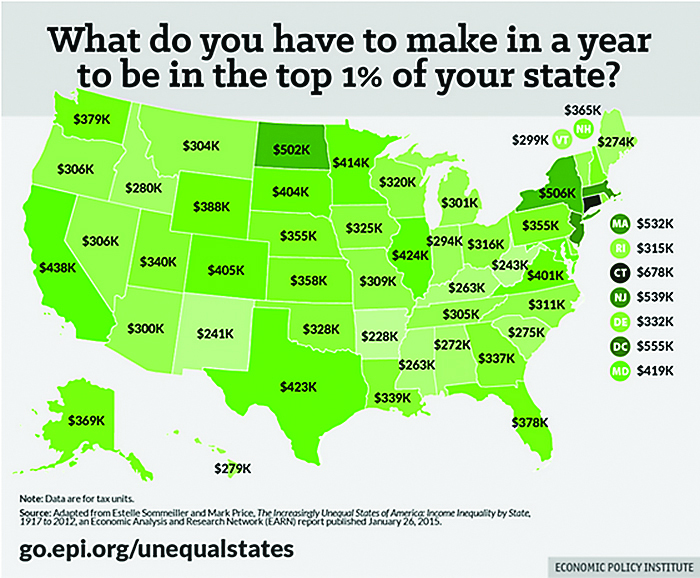The wealthiest 1 percent of those in Tennessee, Georgia and Alabama captured nearly half of the states' income gains over the past generation and nearly two thirds of all income gains since the last recession.
Researchers for the Economic Policy Institute found that the wealthiest 1 percent of Americans earned, on average, 30 times more than the bottom 99 percent.
While the income gap was less in Tennessee, Georgia and Alabama where the wealthiest individuals were usually not quite as rich, tax returns indicate that even in the South the top 1 percent of wage earners captured nearly as much in income gains as the entire rest of the population.
Income inequality
* In Tennessee, the top 1 percent earn 24 times more than the bottom 99 percent * In Georgia, the top 1 percent earn 23 times more than the bottom 99 percent * In Alabama, the top 1 percent earn 21 times more than the bottom 99 percent * Nationwide, the top 1 percent earn 30 times more than the bottom 99 percent Source: Economic Policy Institute study based upon IRS tax data from 1979 to 2012
The lopsided income growth was even more pronounced from 2009 to 2012 coming out of the worst economic downturn since the Great Recession.
"Unfortunately, the Great Recession was no great leveler," said Estelle Sommeiller, a socio-economist at the Institute for Research in Economic and Social Sciences in France and co-author of the study on income growth in America released Monday. "The top 1 percent is recovering, but the bottom 99 percent's income has actually gone down in the so-called recovery."
The gap widened in every state except West Virginia. In 39 states, including most of the South, the majority of income gains after the Great Recession accrued to top 1 percent.
Mark Price, an economist at the Keystone Research Center in Harrisburg, Pa. who studied the data, called the first years coming out of the recession "a perfect storm" for income inequality with a sluggish recovery, decreased demand for unskilled workers, declining labor union strength and a relatively lower minimum wage compared with earlier times.
"All of those factors have combined to really hold down income growth for most workers and has generated the pattern that we are seeing in the economy," he said. "State leaders and policymakers need to realize that inequality is a problem everywhere."
The wage disparity grew both in Georgia, where income growth over the past three decades has been faster than the U.S. as a whole, and in Alabama and Tennessee, where wage growth overall has lagged the national average.
Price warned that income inequality, especially if it continues to grow, could hurt economic growth and undermine support for democratic values.
Both President Obama and Republicans eager to succeed Obama in the White House have decried the lack of wage growth for most workers in the economy.
GOP critics of the president claim ObamaCare, regulations and higher taxes are curbing economic growth and hurting ordinary Americans. Obama is pushing for a higher federal minimum wage and free community college education to help low- and middle-income Americans boost their economic standing.
The study by the Economic Policy Institute said income inequality has been rising since the late 1970s and is now at, or in some states now above, the peak disparity levels previously reached in 1929 before the Great Depression.
Economists expect pay levels to improve as labor markets tighten and employers bid up wages. But with historically high jobless rates and low labor force participation, employers have been able to hire and keep workers without the wage gains typical in a 5-year-old recovery.
In a separate study also done by the Economic Policy Institute, economists noted that the drop in manufacturing jobs which typically pay higher wages has hurt many middle-income Americans.
An EPI study found that full-time manufacturing jobs for non-college degree workers pay a wage premium of more than $3,700 annually over jobs in other economic sectors. In Tennessee, the average manufacturing worker makes $16.10 an hour compared to $14.75 an hour for other workers, an annual wage difference of $2,808.00 for the usual 2,080 hours of full-time work per year.
But the study found that the United States lost 5.7 million manufacturing jobs between March 1998 and December 2013,
Manufacturing jobs make up 11.6 percent of total state employment in Tennessee, or 319,000 jobs.
"Manufacturing's wage premium is a clear path to the middle class," said Scott Paul, president of the Alliance for American Manufacturing.
Contact Dave Flessner at dflessner@timesfreepress.com or at 757-6340.

